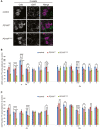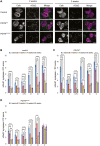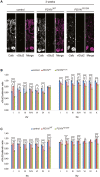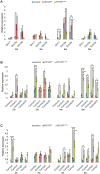Cerebellar developmental deficits underlie neurodegenerative disorder spinocerebellar ataxia type 23
- PMID: 33043513
- PMCID: PMC7983976
- DOI: 10.1111/bpa.12905
Cerebellar developmental deficits underlie neurodegenerative disorder spinocerebellar ataxia type 23
Abstract
Spinocerebellar ataxia type 23 (SCA23) is a late-onset neurodegenerative disorder characterized by slowly progressive gait and limb ataxia, for which there is no therapy available. It is caused by pathogenic variants in PDYN, which encodes prodynorphin (PDYN). PDYN is processed into the opioid peptides α-neoendorphin and dynorphins (Dyn) A and B; inhibitory neurotransmitters that function in pain signaling, stress-induced responses and addiction. Variants causing SCA23 mostly affect Dyn A, leading to loss of secondary structure and increased peptide stability. PDYNR212W mice express human PDYN containing the SCA23 variant p.R212W. These mice show progressive motor deficits from 3 months of age, climbing fiber (CF) deficits from 3 months of age, and Purkinje cell (PC) loss from 12 months of age. A mouse model for SCA1 showed similar CF deficits, and a recent study found additional developmental abnormalities, namely increased GABAergic interneuron connectivity and non-cell autonomous disruption of PC function. As SCA23 mice show a similar pathology to SCA1 mice in adulthood, we hypothesized that SCA23 may also follow SCA1 pathology during development. Examining PDYNR212W cerebella during development, we uncovered developmental deficits from 2 weeks of age, namely a reduced number of GABAergic synapses on PC soma, possibly leading to the observed delay in early phase CF elimination between 2 and 3 weeks of age. Furthermore, CFs did not reach terminal height, leaving proximal PC dendrites open to be occupied by parallel fibers (PFs). The observed increase in vGlut1 protein-a marker for PF-PC synapses-indicates that PFs indeed take over CF territory and have increased connectivity with PCs. Additionally, we detected altered expression of several critical Ca2+ channel subunits, potentially contributing to altered Ca2+ transients in PDYNR212W cerebella. These findings indicate that developmental abnormalities contribute to the SCA23 pathology and uncover a developmental role for PDYN in the cerebellum.
Keywords: GABAergic transmission; ataxia; climbing fibers; development; prodynorphin.
© 2020 The Authors. Brain Pathology published by John Wiley & Sons Ltd on behalf of International Society of Neuropathology.
Conflict of interest statement
The authors declare that they have no conflict of interest.
Figures







Similar articles
-
Elevated mutant dynorphin A causes Purkinje cell loss and motor dysfunction in spinocerebellar ataxia type 23.Brain. 2015 Sep;138(Pt 9):2537-52. doi: 10.1093/brain/awv195. Epub 2015 Jul 12. Brain. 2015. PMID: 26169942
-
Prodynorphin mutations cause the neurodegenerative disorder spinocerebellar ataxia type 23.Am J Hum Genet. 2010 Nov 12;87(5):593-603. doi: 10.1016/j.ajhg.2010.10.001. Epub 2010 Oct 28. Am J Hum Genet. 2010. PMID: 21035104 Free PMC article.
-
The frequency of spinocerebellar ataxia type 23 in a UK population.J Neurol. 2013 Mar;260(3):856-9. doi: 10.1007/s00415-012-6721-1. Epub 2012 Oct 30. J Neurol. 2013. PMID: 23108490
-
Progress in pathogenesis studies of spinocerebellar ataxia type 1.Philos Trans R Soc Lond B Biol Sci. 1999 Jun 29;354(1386):1079-81. doi: 10.1098/rstb.1999.0462. Philos Trans R Soc Lond B Biol Sci. 1999. PMID: 10434309 Free PMC article. Review.
-
Influence of parallel fiber-Purkinje cell synapse formation on postnatal development of climbing fiber-Purkinje cell synapses in the cerebellum.Neuroscience. 2009 Sep 1;162(3):601-11. doi: 10.1016/j.neuroscience.2008.12.037. Epub 2008 Dec 31. Neuroscience. 2009. PMID: 19166909 Review.
Cited by
-
A Massively Parallel CRISPR-Based Screening Platform for Modifiers of Neuronal Activity.bioRxiv [Preprint]. 2025 Feb 10:2024.02.28.582546. doi: 10.1101/2024.02.28.582546. bioRxiv. 2025. PMID: 39990495 Free PMC article. Preprint.
-
Pathological Bergmann glia alterations and disrupted calcium dynamics in ataxic Canavan disease mice.Glia. 2023 Dec;71(12):2832-2849. doi: 10.1002/glia.24454. Epub 2023 Aug 23. Glia. 2023. PMID: 37610133 Free PMC article.
References
-
- Altier C, Zamponi GW (2006) Opioid, cheating on its receptors, exacerbates pain. Nat Neurosci 9:1465–1467. - PubMed
Publication types
MeSH terms
Substances
Supplementary concepts
Grants and funding
LinkOut - more resources
Full Text Sources
Research Materials
Miscellaneous

